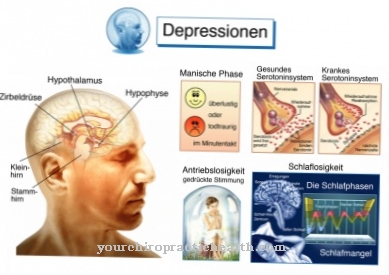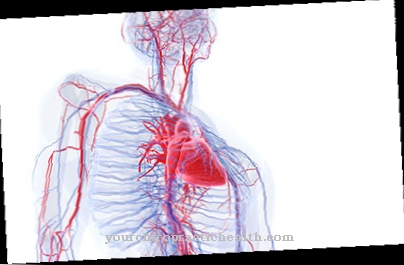If most or all of the cerebral functions fail but the brain stem, diencephalon and spinal cord functions remain, then one Vegetative state or. apallic syndrome (English Persistent Vegetative State, PVS) spoken. The patient seems awake, although he is probably unconscious. A persistent vegetative state must be distinguished from the minimum state of consciousness (MCS) and locked-in syndrome, even if the transitions are fluid.
What is a vegetative state?
A Vegetative state or. appalian syndrome is defined by a holistic loss of consciousness and the ability to communicate.
It also leads to intestinal and urinary bladder incontinence. Sleep and wake rhythms are disturbed, but the basic vital functions such as circulation, breathing and digestion still work. The patients can also sleep and occasionally react to stimuli. Those affected seem awake to outsiders, but this impression is largely deceptive.
The pathways between the cerebrum and the brain stem are badly damaged. While the brain stem is still functioning, the cerebral function is severely impaired. Some patients wake up at some point, while others never return to a normal state of consciousness.
The vegetative state or the Appalian syndrome is therefore a complex and very serious clinical picture that is treated in the intensive care unit of a hospital.
causes
The Vegetative state is always a consequence of very severe damage to the brain. The damage is often triggered by a traumatic brain injury or a lack of oxygen caused by a cardiac arrest.
Other causes of these neurological diseases are a stroke, meningitis and brain tumors. Neurodegenerative diseases, such as Parkinson's syndrome, can also trigger apallic syndrome. There are also cases in which extremely persistent hypoglycaemia can lead to a vegetative state.
Whatever the trigger, there is severe damage to the cerebrum. Often other important brain regions are also permanently damaged, so that a vegetative state or apallic syndrome is caused.
Symptoms, ailments & signs
The so-called vegetative state or apallic syndrome is characterized by an extensive standstill in communication options. The patient usually requires intensive medical treatment at the time of diagnosis. He has often survived an accident with severe brain injuries or has fallen into a vegetative state through other circumstances. At first he has to be artificially ventilated and fed intravenously.
The vegetative state usually occurs suddenly. Only in certain neurodegenerative diseases can the symptoms appear gradually. A typical symptom is that the person concerned seems awake. Although his eyes are open, they look into space. Obviously, they are not aware of what is going on around them. Whether there is no perception at all is debatable. Caregivers often experience that high blood pressure or other signals indicate a certain ability to react.
Other symptoms include aphasia, incontinence, spasticity or involuntary movement patterns. Reflexes and breathing reflexes are typically retained. In a later stage of the apallic syndrome, muscle shortening, muscle twitching, racing heart, sweating or high blood pressure can occur.
These symptoms are taken as a sign of a no longer normal functioning autonomic nervous system. Only in a few cases do patients wake up after years of being in a coma. In most cases, lying down for a long time will lead to a pressure ulcer. Pneumonia can be fatal through long ventilation.
Diagnosis & course
Diagnosing one Awake comas occurs clinically and usually lasts several weeks or months. Severe neurological defect syndromes need to be revealed. Apparatus diagnostics are used for this, which include magnetic resonance imaging, the electroencephalogram and evoked potentials.
They are used in a network, as none of these examination methods are suitable for diagnosis alone. It must be differentiated from other clinical pictures such as locked-in syndrome and coma. If a vegetative state has been found, the relatives must be prepared for a treatment success that is less than 50%. A better prognosis is given if the vegetative state is just beginning, the patient is young and there is traumatic brain damage.
An improvement in the coma or apallic syndrome is unlikely if, for example, the brainstem reflexes are absent for more than 24 hours, no pupillary reaction has been shown for three days, or massive cerebral edema is shown on CT.
Complications
Patients who fall into a vegetative state suffer from both acute complications and long-term effects, which often only become noticeable after awakening. Typical problems include incontinence and being bedridden, usually associated with other consequences such as inflammation, sores and circulatory disorders. After awakening, the patient usually suffers from delirium, which can persist for several days to weeks.
In the case of a persistent vegetative state, permanent mental complaints are also possible. A prolonged coma often has an impact on the patient's psyche. Depressive moods, changes in personality or severe dissociative disorders then occur.
Anxiety disorders can also occur as part of an apallic syndrome. An existing vegetative state leads to a decrease in brain activity and can be fatal as a result of the complications. An improvement in the coma becomes increasingly unlikely as the disease progresses.
If the patient is tube fed, there are potential risks of injuring the stomach, small intestine, or esophagus. In individual cases, the feeding tube is placed in the windpipe instead of the esophagus, which can lead to serious injuries and infections. In some cases, the drugs administered can cause unforeseen side effects.
When should you go to the doctor?
A doctor is required as soon as the person concerned can no longer be addressed and there is no possibility of communication with him. An ambulance service must be alerted as intensive medical care is necessary. Until the doctor arrives, the instructions given by the emergency doctor team must be followed. Otherwise there is a risk of the affected person's sudden death. If the complaints arise after an accident, a fall or a force, action must be taken as quickly as possible. Due to its nature, in a vegetative state, the person affected cannot undertake any activities to seek help. People present are therefore requested to react immediately.
First aid measures must be used to ensure the survival of the person concerned. Involuntary movements, irregular heartbeat or twitching of various muscles on the person's body indicate an existing disorder. A failure to breathe, a pale appearance and a blank look are also to be interpreted as warning signals of the organism. If the ability to react does not occur despite all efforts, the body does not react to the natural reflexes either and sudden changes occur within a few minutes, the emergency doctor should be called. In some cases, the development of health problems can be observed gradually. Nevertheless, in a vegetative state, the help of those present is essential.
Treatment & Therapy
Treatment of the apallic syndrome is based on the development phases of neurological early rehabilitation. The focus of therapy is acute treatment. In this phase, an incision is usually made in the trachea and a feeding tube is placed through the abdominal wall.
Usually, a urine drain is also placed through the abdominal wall. This secures the vital functions and allows the best possible nursing care for the patient. Applications by physiotherapists and speech therapists should also be carried out in this phase. After the acute treatment has been completed, the next phase follows. The therapy is expanded to include neuropsychological measures and occupational therapy.
Music therapy is also used in some patients. The aim of these treatment methods is to improve mental, motor and psychological functions. In this phase, which can last from a month to a year, the further course of the patient's state of health is decided. If there is a noticeable improvement in mental and physical performance, further measures can be taken.
If the person concerned remains in an unconscious state, the so-called "activating treatment care" is initiated. Therapy of a coma awake or apallic syndrome always takes place under medical supervision, as this is also required and checked by the insurance companies.
prevention
The Vegetative state cannot be prevented directly. Any severe damage to the head and brain should be avoided, however, as this could affect brain functions. If the vegetative state or apalllic syndrome is already present, the condition of the person affected can occasionally be improved a little through targeted therapeutic measures.
Aftercare
After a vegetative state, follow-up care plays an extremely important role. Thus, depending on the extent of their activity restrictions, the patients continue to need care even after their discharge from the hospital. This also applies to regained independence. The rehabilitative aftercare takes place on an outpatient basis and extends over a longer period of time, the duration of which cannot always be determined.
Possible aftercare treatments include 24-hour care, out-of-hospital intensive care that includes ventilation, and a shared flat that is cared for on an outpatient basis. In mild cases, assisted living can also be carried out. Some of those affected are even able to work in a special workshop for disabled people.
On the other hand, other affected persons require permanent care in a day care center, a practice for outpatient neurorehabilitation or in a coma house. Many patients can still recover from apallic syndrome after years in their familiar surroundings. Consultations are possible through the care insurance.
They have the task of advising those affected individually on care within their own domesticity. Special care support points are also available in numerous regions. Early rehabilitation is an important part of aftercare. It continues acute treatment from the hospital and includes therapeutic care, physiotherapeutic measures, speech and swallowing therapy, occupational therapy and neuropsychological treatments. The aim is to improve the patient's state of consciousness.
You can do that yourself
In a vegetative state, the patient naturally cannot initiate any self-help measures. In this state of health, the person concerned appears to be awake. In fact, however, his state of consciousness is minimal or nonexistent. In this situation, he is completely dependent on the support and help of the medical team providing care and the relatives.
Normally the person concerned is in an inpatient stay. Here, the necessary care measures are automatically carried out by medical staff. The close cooperation of the relatives with the nurses or helpers of the treating station is helpful and recommended. Daily checks should be made at regular intervals to ensure that the points of contact on the patient's body are not developing any pressure points or wounds. Therefore, the affected person's body has to be moved or changed in position repeatedly. Continuous creaming of the contact points has also proven to be helpful. The patient's surroundings must be supplied with fresh air several times a day. The oxygen supply supports the organism in the healing process. At the same time, it must be ensured that the person concerned is not cold or exposed to an increased risk of infection.
Although there is insufficient statistical evidence for this, patients repeatedly report with hindsight that communication from family members to patient has a positive influence on the recovery process.

.jpg)


.jpg)



















.jpg)



